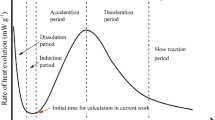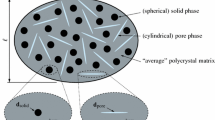Abstract
The effective diffusion coefficients of hardened cement pastes can vary between a few orders of magnitude. The paper aims at building a homogenization model to estimate these macroscopic diffusivities and capture such strong variations. For this purpose, a three-scale description of the paste is proposed, relying mainly on the fact that the initial cement grains hydrate forming a complex microstructure with a multi-scale pore structure. In particular, porosity is found to be well connected at a fine scale. However, only a few homogenization schemes are shown to be adequate to account for such connectivity. Among them, the mixed composite spheres assemblage estimate (Stora, E., He, Q.-C., Bary, B.: J. Appl. Phys. 100(8), 084910, 2006a) seems to be the only one that always complies with rigorous bounds and is consequently employed to predict the effects of this fine porosity on the material effective diffusivities. The model proposed provides predictions in good agreement with experimental results and is consistent with the numerous measurements of critical pore diameters issued from mercury intrusion porosimetry tests. The evolution of the effective diffusivities of cement pastes subjected to leaching is also assessed by adopting a simplified scenario of the decalcification process.
Similar content being viewed by others
References
Bary B. and Béjaoui S. (2006). Assessment of diffusive and mechanical properties of hardened cement pastes using a multi-coated sphere assemblage model. Cem. Concr. Res. 35(2): 245–258
Béjaoui S., Bary B., Nitsche S., Chaudanson D. and Blanc C. (2006). Experimental and modeling studies of the link between microstructure and effective diffusivity of cement pastes. Revue Européenne de Génie Civil 10(9): 1073–1106
Béjaoui S. and Bary B. (2007). Modeling of the link between microstructure and effective diffusivity of cement pastes using a simplified homogenization method. Cem. Concr. Res. 37(3): 469–480
Bernard O., Ulm F.-J. and Lemarchand E. (2003). A multiscale micromechanics-hydration model for the early-age elastic properties of cement-based materials. Cem. Concr. Res. 33(9): 1293–1309
Bergman D.J. (1976). Calculation of bounds for some average bulk properties of composite materials. Phys. Rev. B 14: 1531
Berryman J.G. (2005). Bounds and estimates for transport coefficients of random and porous media with high contrasts. J. Appl. Phys. 97(6): 1–11
Bruggeman D.A.G. (1935). Berechnung verschiedener Physikalischer Konstanten von heterogenen Substanzen. Ann. Phys. 24: 636–679
Caré S. and Hervé E. (2004). Application of a n-phase model to the diffusion coefficient of chloride in mortar. Transp. Porous Med. 56(2): 119–135
Constantinides G. and Ulm F.-J. (2004). The effect of two types of C-S-H on the elasticity of cement-based materials: results from nano identation and micro mechanical modelling. Cem. Concr. Res. 34(1): 67
Diamond S. (2000). Mercury porosimetry – an inappropriate method for the measurement of pore size distributions in cement-based materials. Cem. Concr. Res. 30(10): 1517–1525
Eshelby J.D. (1957). The determination of the elastic field of an ellipsoidal inclusion and related problems. Proc. Roy. Soc. Lond. Ser. A 241: 376–396
Gallé C. (2001). Effect of drying on cement-based materials pore structure as identified by mercury intrusion porosimetry: a comparative study between oven-, vacuum- and freeze-drying. Cem. Concr. Res. 31(10): 1467–1477
Gallé C., Peycelon H. and Le Bescop P. (2004). Effect of an accelerated chemical degradation on water permeability and pore structure of cement-based materials. Adv. Cem. Res. 16(3): 105–114
Garboczi E.J. and Bentz D.P. (2001). The effect of statistical fluctuation, finite size error and digital resolution on the phase percolation and transport properties of the NIST cement hydration model. Cem. Concr. Res. 31(10): 1501–1514
Garboczi E.J., Snyder K.A., Douglas J.F. and Thorpe M.F. (1995). Geometrical percolation threshold of overlapping ellipsoids. Phys. Rev. E 52(1): 819–828
Gilormini P. (2001). Realizable compressibility and conductivity in isotropic two-phase composites. C. R. Acad. Sci. Paris Ser. IIb 329: 851–855
Hashin Z. and Shtrikman S. (1962). A variational approach to the theory of the effective magnetic permeability of multiphase materials. J. Appl. Phys. 33: 3125–3131
Hervé E. (2002). Thermal and thermoelastic behaviour of multiply coated inclusion-reinforced composites. Int. J. Solids Struct. 39(4): 1041–1058
Igarashi S., Kawamura M. and Watanabe A. (2004). Analysis of cement pastes and mortars by a combination of backscatter-based SEM image analysis and calculations based on the Powers model. Cem. Concr. Comp. 26(8): 977–985
Jennings H.M. (2000). A model for the microstructure of calcium silicate hydrates in cement paste. Cem. Concr. Res. 30(1): 101–116
Kirkpatrick S. (1971). Classical transport in disordered media: scaling and effective-medium theories. Phys. Rev. Lett. 21: 1722–1725
Kirkpatrick S. (1973). Percolation and conduction. Rev. Mod. Phys. 45: 574–588
Kuster G.T. and Toksöz M.N. (1974). Velocity and attenuation of seismic waves in two-phase media: I. Theoretical formulation. Geophysics 21: 571–574
Landauer R. (1952). The electrical resistance of binary metallic mixtures. J. Appl. Phys. 23: 779–750
Ma H., Hu G. and Huang Z. (2004). A micromechanical method for particulate composites with finite particle concentration. Mech. Mater. 36(4): 359–368
Maxwell J.C. (1873). A Treatise on Electricity and Magnetism. Clarendon Press, Oxford
McLachlan D.S. (1987). An equation for the conductivity of binary mixtures with anisotropic grain structures. J. Phys. C: Solid State Phys. 20: 865–877
Mélé P., Marceau S., Brown D. and Albérola N.D. (2005). Consequences of the aggregation and the percolation of fillers on the viscoelastic behaviour of nanocomposites. C. R. Mecanique 333: 155–161
Mori T. and Tanaka K. (1973). Average stress in matrix and average elastic energy of materials with misfitting inclusions. Acta Metall. Mater. 21: 571–574
Milton G.W. (1981). Concerning bounds on the transport and mechanical properties of multicomponent composite materials. Appl. Phys. A 26: 125–130
Milton G.W. (1985). The coherent potential approximation is a realizable effective medium scheme. Commun. Math. Phys. 99: 463
Norris A.N. (1985). A differential scheme for the effective moduli of composite. Mech. Mater. 4(1): 1–16
Planel, D.: Les effets couplés de la précipitation d’espèces secondaires sur le comportement mécanique et la dégradation chimique des bétons. PhD-dissertation, Univ. Marne-La-Vallée, France (2002)
Ponte Castaneda P. and Willis J.R. (1995). Effect of spatial distribution on the effective behavior of composite materials and cracked media. J. Mech. Phys. Solids 43(12): 1919–1951
Powers, T.C., Brownyard, T.L.: Studies of the physical properties of hardened cement pastes. J. Am. Concr. Inst. 43 (1948)
Oh B.H. and Jang S.Y. (2004). Prediction of diffusivity of concrete based on simple analytical equations. Cem. Concr. Res. 31(10): 463–480
Richardson I.G. (2000). The nature of the hydration products in hardened cement pastes. Cem. Concr. Comp. 22: 97–113
Richet, C., Pin, M., Adenot, F., Maury, J., Lalle, J.P., Fockedey, C.: Amélioration de la fiabilité du modèle DIFFUZON. Technical note CEA, NT SESD 97.37 (1997)
Rintoul, M.D., Torquato, S.: Precise determination of the critical threshold and exponents in a three-dimensional continuum percolation model. J. Phys. A 30(16), L585–L592 (1997)
Shante V.K.S. and Kirkpatrick S. (1971). An introduction to percolation theory. Adv. Phys. 20: 325–356
Stora E., He Q.-C. and Bary B. (2006a). A mixed composite spheres assemblage model for the transport properties of random heterogeneous materials with high contrasts. J. Appl. Phys. 100(8): 084910
Stora E., He Q.-C. and Bary B. (2006b). Influence of inclusion shape on the effective linear elastic properties of hardened cement pastes. Cem. Concr. Res. 36(7): 1330–1344
Tennis P.D. and Jennings H.M. (2000). A model for two types of calcium silicate hydrate in the microstructure of Portland cement pastes. Cem. Concr. Res. 30(6): 855–863
Torquato S. (2001). Random Heterogeneous Materials: Microstructure and Macroscopic Properties. Springer-Verlag, New York
Zaoui, A.: Matériaux hétérogènes et composites. Lecture notes, Ecole Polytechnique, Paris (1997)
Zheng Q.-S. and Du D.-X. (2001). An explicit and universal applicable estimate for the effective properties of multiphase composites which accounts for inclusion distribution. J. Mech. Phys. Solids 49: 2765–2788
Zimmerman R.W. (1984). Elastic moduli of a solid with spherical pores: new self-consistent method. Int. J. Rock Mech. 21(6): 339–343
Zimmerman R.W., King M.S. and Monteiro P.J.M. (1986). Elastic moduli of mortar as a porous-granular material. Cem. Concr. Res. 16(2): 239–245
Author information
Authors and Affiliations
Corresponding author
Rights and permissions
About this article
Cite this article
Stora, E., Bary, B. & He, QC. On Estimating the Effective Diffusive Properties of Hardened Cement Pastes. Transp Porous Med 73, 279–295 (2008). https://doi.org/10.1007/s11242-007-9170-z
Received:
Accepted:
Published:
Issue Date:
DOI: https://doi.org/10.1007/s11242-007-9170-z




